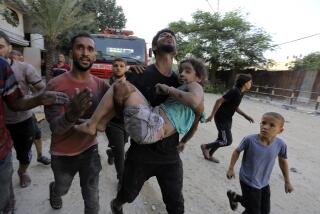We Could Give the Gift of Life This Christmas : Children: The means exist to stop needless deaths from hunger and disease in the Third World. But do we have the will?
- Share via
If the planet could look under its own tree Christmas morning to find gifts of human progress, one package--unimaginable several years ago--would contain the political achievements that are thawing the Cold War. If the wrapping paper had newspaper headlines printed on it, those headlines might read: “Berlin Wall Down” or “Non-Communist Government in Poland.”
Another package--perhaps at the top of the planet’s wish list--would hold a reprieve for our suffering environment. The headlines on the wrapping paper might announce, “Agreement on Global Warming” or “Recycling on the Increase.”
But a third package would lie hidden in the back, unlikely to be opened or even seen. This package could provide a remedy for another calamity--the needless deaths of 40,000 Third World children each day from hunger and poverty. It’s wrapping paper would be blank, because there have been no headlines. But if this gift came with an instruction booklet, it would certainly be the United Nations Children’s Fund’s 1990 report, “the State of the World’s Children.”
The report tells us that even with the current rate of progress, 100 million children will die during the 1990s from illness and malnutrition. These deaths won’t come from floods or famine. They won’t be covered by television; an outraged public will not demand action.
The world will hardly notice as young lives are lost to diseases that were once killers in developed countries. As the report states, “They will die in the sunken-eyed coma of dehydration, or in the gasping extremities of pneumonia, or in the iron grip of tetanus, or in the fever of measles, or on the rack of whooping cough.” Most important, the report reveals that these deaths are needless and could be prevented at low cost.
UNICEF has proposed a World Summit for Children next year, at which heads of state would make this situation the world’s highest priority. The UNICEF report outlines several major opportunities to protect the lives and normal growth of children:
Universal immunization . The increase in immunizations this decade saves about 2 million lives each year from measles, tetanus, whooping cough and other deadly diseases, yet 3 million youngsters continue to die yearly because about one-third of the world’s children haven’t been vaccinated. The vaccines cost less than $1.50 per child.
Oral rehydration therapy . A 10-cent packet of oral rehydration salts saves about 1 million lives each year, but only one out of three families in the Third World uses the solution.
Acute respiratory infections . Hundreds of thousands of children could be saved each year if community-health workers were trained to administer simple antibiotics, which cost about $1 per course.
Breast feeding . Bottle-fed infants contract many more illnesses and are as much as 25 times more likely to die in childhood than infants who are breast-fed exclusively for the first six months of life.
Making today’s low-cost solutions available to the world’s children would cost about $2.5 billion a year. That’s what the Soviets spend on vodka each month, or American companies spend on cigarette advertising each year. It’s also 10% of the European Community’s annual agricultural subsidy.
Half of the developing nations’ annual expenditures are allocated for military spending and debt servicing. The developed world devotes more than six times this much--about $855 billion--to military spending. UNICEF asserts that the industrialized world has a major role to play in helping the developing world by “opening up the debt trap, renewing investment, liberalizing trade, compensating for steep falls in commodity prices and increasing the level of aid . . .”
Five years ago, UNICEF’s report on the state of the world’s children said that we have the knowledge, techniques and organizational capacity to save these millions of young lives and concluded:
“We are therefore confronted with a stark question: Do we have the will?
“And of those who would argue that it is not a matter of will but of resources, it must now be asked--how low does the cost have to fall before the will is found? We are now talking about a particular opportunity to save the lives of (millions of) young children a year. . . . If the will to accept that challenge is missing, then perhaps it will never be there. For in all realism, it is unlikely that there will ever again be such an opportunity to do so much for so many, and for so little.”
The children are still dying to know if we have the will.
More to Read
Sign up for Essential California
The most important California stories and recommendations in your inbox every morning.
You may occasionally receive promotional content from the Los Angeles Times.













